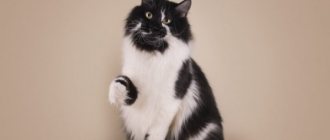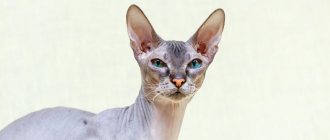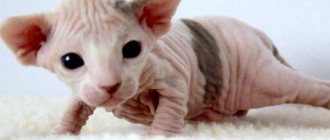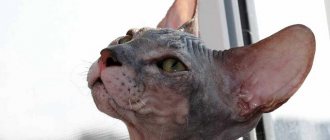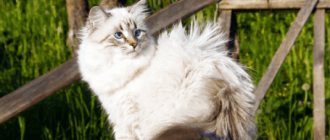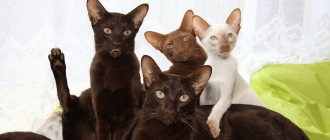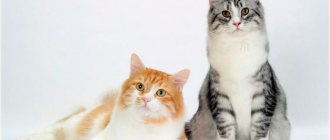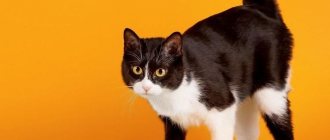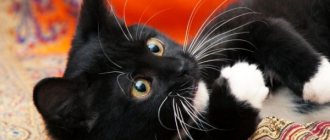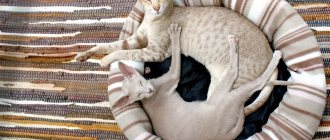Breeds without hair
- Fact 1:
Ancient chronicles contain references to hairless cats in Egypt, India and America - Fact 2:
Hairless Sphynxes, which are descended from those hairless kittens, look very similar to surviving images of Aztec cats - Fact 3:
There are suggestions that in ancient times hairless cats lost their hair due to the climatic characteristics of the regions - Fact 4:
Each breed has unique traits that distinguish it from its relatives.
When most people hear the word “cat,” they conjure up an image of a creature with soft, thick fur that is so pleasant to touch. Hairless cats seem to be created to contradict this stereotype. Among the many cat breeds, they occupy a special position and cannot boast of being particularly popular, although the history of their existence goes back more than one thousand years.
Ancient chronicles contain references to hairless cats in Egypt, India and America from those times when it still completely belonged to the Indians. These cats lived in palaces and temples, their images were preserved on wall paintings, art objects and ritual attributes.
At the beginning of the 20th century, writer Francis Simpson, in his book, shared with readers the story of how he received two Aztec hairless cats as a gift from the Indians of Mexico. These individuals are considered the last representatives of their unique breed, and they sank into oblivion without leaving offspring.
However, several decades later, almost simultaneously, in different parts of the United States and Canada, several hairless kittens were born to ordinary outbred cats. There are suggestions that this is how echoes of distant spontaneous matings of hairless Mexican cats with ordinary domestic cats manifested themselves. At least the hairless sphinxes, which are descended from those hairless kittens, look very similar to surviving images of Aztec cats.
The history of hairless cats
The hairless gene, the result of mutations, has been manifested for several hundred years in a wide variety of cat litters. This phenomenon was not tied to a specific country or breed, and was perceived rather as a deviation from the norm.
The hairless cat and cat, bought from the Aztec Indians in the vicinity of New Mexico by Mr. Shinnik, are mentioned in the works of Francis Simpson. The owner of the unusual pets, although he was unable to prolong their family, presented their detailed characteristics. These events gave impetus to more detailed research and new assumptions.
Gradually, Mexican cats were associated with animals from South America, which were mentioned in the works of the German scientist Jozan Rudolf Rengger back in 1830. He suggested that they were brought from Europe back in the 15th century, and the loss of wool was provoked by a sharp climate change.
In the middle of the 20th century, furless kittens appeared from Siamese in France, but their crossing did not bring practical results. Therefore, the ancestor of the breed is considered to be a cat from Canada, born in 1966.
Gradually, his descendants began to be called sphinxes, for which there are many explanations. Some believe that this was due to the external resemblance to the sculpture of the same name, as well as attempts to convey an unusual aura and extraterrestrial appearance. Others are confident that Egyptian writings describe hairless cats, from whom the graceful image was borrowed when creating sculptures and painting the walls of ancient temples.
Hairless cats have their own unique beauty and grace; they are “aliens” of the animal world. We recommend that you read an article about some of the most beautiful cat breeds that exist in our world, long- and short-haired, and, of course, hairless.
Hairless cat breeds
Over time, hairless cats received official recognition and their own standard. Breeders have learned to breed new varieties of them, among which there are now the Canadian, Donskoy and St. Petersburg Sphynxes, as well as the Ukrainian Levkoy, Elf, Bambino and Hawaiian hairless (Kohona). All of them differ significantly from each other not only in appearance, but also in the nature of the hairlessness gene, which can be dominant or recessive.
For example, Hawaiians lack hair follicles, which makes their skin look like wax, while Canadians' skin feels more like soft velvet with small fibers.
Cohona or Hawaiian hairless cat
Description and breed standards
Three breeds of Sphynx were officially recognized - Canadian, Donskoy and Peterbald. Standards were created for each of them, and specialized organizations were founded to maintain them. The largest of them is ISBFA, the International Sphynx Fanciers and Breeders Association, registered in the USA.
The standard appearance of these cats includes:
- medium-sized body with unusual grace, sophistication and developed muscles;
- almost complete absence of hair, too short and feels like velvet;
- the location of the folds on the skin indicates the species of the animal;
- There may be eyebrows, whiskers or wool tassels on the tail, paws, and ears.
The outlines of the head and body of different cats differ, which allows felinologists to accurately distinguish one representative from another. But what they all have in common is an excellent temperament and devotion to the owner, which only dogs differ.
Read the article about the differences between the Don and Canadian sphinxes.
Colors
In such pets, the colored pigment appears on the skin, and can have any color:
- plain black, white, red, blue-gray, brown, pinkish or purple;
- two-tone gray with white or purple, black with chocolate;
- tabby black, red, cream, blue, lavender, cream;
- tortoiseshell black or brown with red spots, or blue-cream, lilac-cream;
- van, harlequin, bicolor with clearly defined boundaries of the main color and white;
- Siamese colorpoint in different shades.
Due to the lack of hair, sphinxes do not have a smoky color, which is fully compensated by their diversity. The patterns on the skin are completely individual for each cat. Moreover, in moderation, sunbathing will make its colors brighter and more saturated.
TOP 10 breeds of hairless cats
To date, nine varieties of hairless cats are known, only three of which were obtained naturally - the Donskoy, Canadian Sphynx and Cohona. They arose as a result of a spontaneous mutation, for which different genes are responsible in each case.
Crossing these representatives with others made it possible to obtain:
- Peterbald from Donskoy and Oriental;
- Bambino from Canadian and Munchkin;
- Levkoya from Donchak and Scottish Fold;
- Minskin from Munchkin, Canadian, Devon Rex and Burmese;
- Elf from the American Curl, and Dwelf with the addition of the Munchkin gene.
Canadian Sphynx
The Canadian Sphynx is the most popular among felinological organizations in all countries, as well as among amateurs.
It can be characterized as follows:
- thick skin is dense and soft to the touch, sometimes has fluff;
- folds on the forehead, neck, and paws smooth out slightly with age;
- muscular pear-shaped body with thin legs;
- the whip-like long tail is curled in a semicircle;
- wedge-shaped head with prominent cheekbones;
- large rounded ears;
- expressive eyes resemble lemons in outline.
Thanks to its unearthly appearance, the Canadian is often called the “moon cat” and is considered one of the most beautiful representatives of the hairless cat.
Also read the article about Canadian Sphynxes.
Don Sphynx
Don cats, originally from Rostov-on-Don, were called “Russian hairless” for some time. A distinctive feature is the presence of different types of hair:
- its complete absence;
- thin “flock” fluff (like a peach), disappearing by two years;
- more noticeable “velor” hairs 2-3 mm long;
- short-haired “brush” with sparse, coarse hairs.
They can also be identified by their medium-sized body with folds in the groin, neck, forehead and paws. The short wedge-shaped head has expressive cheekbones, serious almond-shaped eyes, and large, slightly pointed ears.
More about the Don sphinxes.
Peterbald
The cat, originally from St. Petersburg, has a physique reminiscent of an elegant Oriental, and the skin and undercoat are soft suede. Therefore, he is considered the most elegant hairless representative, and belongs to the group of oriental cats.
The slender body is elongated, fine-boned, has developed muscles and a proud posture, thin and long limbs. The muzzle is narrow, high cheekbones, with slanted green or blue eyes and huge ears. Folds are present mainly on the scalp, and the fur can be of different types, like the Donchak, but the color is often dark.
Also read the article about the St. Petersburg or Neva sphinxes.
Ukrainian Levkoy
In Kyiv, as a result of crossing, a fold-eared kitten without hair was obtained. Its muzzle has a very unusual structure: a wedge-shaped head with five edges, an elongated neck, slanting green eyes, and, as a highlight, curved ears in the shape of a leftover flower, which is where the name came from.
This cat is flexible and graceful, with a slender body and limbs. It is acceptable to have a small fluff, as well as not too deep folds on the stomach, head and neck.
Read more in the article about Ukrainian Levkoys.
By the way, did you know that Levkoi are prone to aggression if they are not given enough attention? Read about this, as well as about other cat breeds that may turn out to be evil, on our portal Mister Cat.
Elf
Unlike the previous representative, the Elf has rounded ears that are curved not forward, but backward, which is reminiscent of mythical characters. Cashmere folded skin without hair may have wool tufts on the paws.
The body type is typical for hairless cats. The head is wedge-shaped, without vibrissae, with slanted almond-colored eyes.
This cat was bred in 2006 and has not yet become widespread, so it is found in only a few nurseries in North America.
Dwelf came out very similar to him, in whose gene pool there are also traits of the short-legged Munchkin. Short limbs, ears curved to the back of the head and almost complete absence of fur make his appearance very cute and funny. But this breed appeared not so long ago, in 2009, so it is still experimental.
Dwelf
More interesting and educational information about Elves on the Mister Cat portal.
Bambino
With a long body and short legs, the Bambino closely resembles a dachshund. The rounded muzzle with large lemon-like eyes takes on a slightly childish expression, which explains the name. And the ears are large, like all hairless ones, slightly tapering towards the tips. The skin is completely covered with soft folds and has no fur.
These cats themselves are small, weighing no more than 4 kg. And, despite their peculiarity, they are quite playful and agile.
Read about Bambino cats.
Minskin
Another experimental variety is Minskin, which is very similar in appearance to Bambino. Therefore, many experts agree that it is only an analogue of the one obtained earlier. It can be distinguished only by its short fur, slightly longer in the area of the ears, paws, tail and muzzle. Only the stomach always remains bald.
Cohona
The Hawaiian Hairless is one of the few cats whose hairlessness gene was obtained naturally. It is also called rubber because of the characteristic skin that resembles wax to the touch. This is not visible in the pictures, but you can verify everything in person.
Due to the mutation, the cat’s fur is completely absent, as are the hair follicles in it. Therefore, she cannot have a mustache, eyebrows or other vegetation. The folds are very expressive on the cheeks, forehead, neck and paws. The eyes are almond-shaped.
Canadian Sphynx
Among hairless breeds they are the brightest representatives. It is noteworthy that they are called Canadian only in Russia. The Canadian Sphynx breed appeared as a result of mutation and developed naturally.
There is a small fluff on their body, no more than 2 mm long. Also, sparse hair can be on the outside of the ears, scrotum, tail, between the toes and on the bridge of the nose. The skin is thick and forms many folds, especially on the face. Because of this, the cat never leaves an angry expression. The calling card of the breed is lemon-shaped eyes, large erect ears, and sparse or completely absent mustaches.
Sphinxes and aggression are two incompatible concepts. They get along equally well with all family members and other pets. The owner is their idol. They become attached to him once and for all, and separation is hard to bear. Cats cannot be called lazy. They are happy to get involved in any games and know how to amuse themselves. Anything can serve as a toy, from your own tail to a crawling bug.
Peterbald
Mr. Cat recommends: personality traits of hairless cats
All cats without fur have a warm disposition and a pleasant character. Whether this was the result of experiments, or whether it was inherent in nature, many people compare such pets primarily with dogs, always faithful, devoted and affectionate. Very quickly becoming attached to the owner, they have a hard time with a change of environment or a long separation, or constant loneliness.
These are sociable cats, very smart and inquisitive. Some of them are able to carry small objects and are easy to train. They understand human speech well and the tone in which their owners speak to them. They love affection and give it in return.
The good nature of pets will come in handy if there are small children or other animals in the house. They do not show aggression, so they will never offend children or bite or scratch.
Read about the best cat breeds for children.
Moreover, there is an opinion that they have a positive effect on people’s health and psyche.
Bambino
The result of crossing Munchkin and Sphinx turned out to be very funny. The cat's appearance is similar to that of a dachshund. From Munchkin she got short legs and a long body, and large erect ears and a long tail are the merit of the Sphinx. Bambino's weight does not exceed 4 kg. What’s interesting is that his offspring can be born not only with short legs, but also with normal limbs.
Cats of this breed are very inquisitive and curious. Bambinos are absolutely conflict-free; anyone can get along with them. They have a close emotional connection with their owner and are happy to get involved in any mischievous games. But they can also be capricious. Especially in terms of comfort and care. The breed is prone to overeating and obesity, so you should create a feeding schedule for your pet and strictly follow it.
Dwelf
Care and maintenance
Such special animals will require more careful personal care, and the absence of hair does not make life easier for the owners. That is, you need to be prepared that your pets will often sweat, secrete a brownish coating, sunbathe in the summer and freeze in the cool season.
The basic rules for their content are related to this:
- several times a week, wash off the specific brown plaque from the skin that accumulates near the ears, claws and paw pads with a special lotion;
- regularly clean your eyes and ears with a cotton pad or cotton swabs;
- bathe at least once every 2 weeks using shampoos or baby products intended for this purpose, and dry thoroughly with a soft towel;
- trim claws with a nail clipper to avoid animals injuring themselves.
If you take proper care of your pets, you can get the most loyal and sweetest family members.
Bathing a cat
The skin always requires regular care in these breeds, because it sweats very often. However, you can bathe them no more than once every 14 calendar days.
For many pet owners, bathing involves special efforts and even stress. But, regarding sphinxes, you should not worry too much, since it very often coincides that these cats are very fond of water treatments and even know how to swim well.
There are special shampoos for washing such males, but if you do not have such a product, then you can bathe the kitten using baby soap.
Health and allergies
The lack of fur makes hairless cats prone to colds and dermatitis. To avoid this, you should follow these recommendations:
- it is necessary to maintain a temperature regime of 20-25°C in an apartment or house, since their body temperature reaches 40-42 degrees;
- In summer, monitor your exposure to the sun to prevent burns or heat stroke;
- ensure the absence of drafts, special clothing for the winter period, and limit access to hot radiators and heaters;
- regularly perform hygiene procedures, while checking the ears for the presence of mites, the eyes for signs of tearing and inversion of the eyelids;
- streamline your diet to prevent obesity and stomach problems;
- carry out vaccination in accordance with the vaccination calendar at 8 weeks, and annually after a year.
If these recommendations are taken into account, the pet's life expectancy will be 10-17 years. Some individuals lived to be 20, sometimes more.
Hairless cats are often chosen by allergy sufferers, asthmatics and people with similar problems. It is important to remember that among them there are no hypoallergenic ones, although attempts have been made to breed them. Scientists have found that in 80% of cases, an allergic reaction is provoked by the Fel D1 protein, which is produced in the sebaceous glands of cats of all breeds. It is found in cat saliva, urine, dead skin cells, and gets onto the fur during washing. Therefore, if a person is allergic not to wool, but specifically to this protein, then the best way to combat the disease will be to limit contact with the animal. Read the article about hypoallergenic cats.
Pet character
Such animals are quite cute, calm, although active, but they are more like dogs than cats. Why? Because they have strong feelings for their owners, whom, by the way, they choose themselves. It has also been noted that memory and logic are developed quite well, therefore, like dogs, they are easy to train. It is observed that without much difficulty, cats bring in their teeth what the owner asks for.
Since sphinxes are very friendly, loneliness is unbearable for them, so you should not buy such an animal if you are often away from home. And, for the period when there is still no one in the apartment, buy different toys for your pet so that he does not have to get bored.
If the weather is good outside, then the kittens will happily walk with you, having their own leash.
Nutrition
Due to the lack of fur, hairless cats spend twice as much energy to maintain body temperature. Therefore, they need to eat much more nutritiously than ordinary pets.
The diet must be balanced taking into account the requirements:
- Special super premium or holistic granules should not contain many vitamins. Active substances necessary for the growth and maintenance of fur can only harm hairless beauties. Read our review of the best foods for cats and kittens.
- Any food should have a large amount of fat necessary to maintain body temperature. And only proteins and carbohydrates remain at normal levels. So before purchasing ready-made food for kittens, you should carefully read its description.
- Natural food is selected taking into account all requirements, and contains raw beef or poultry, boiled meat, liver and vegetables, and dairy products. They can be mixed into liquid feed, made into a pate, or given pure.
Animal care
As you can see, of all the above breeds, hairless cats are extraordinary animals. Since they are different from other cats, their care must be different.
Newborn kittens can have a body temperature of 40-42°, and this is normal. An adult cat usually has a body temperature of approximately 39°. As we can see, these are very hot creatures. For these reasons, cold is contraindicated for such pets.
Those people who cannot keep a kitten warm during cold seasons should not have such animals. Or for those who themselves cannot stand the heat, and therefore everything at home is always ventilated. Drafts are also contraindicated for hairless cats.
But this does not mean that a cat can warm itself all day long in the sun or under a radiator. Since their skin is very sensitive, they can burn it very easily. Therefore, close control of the owners is necessary in care.
Cost of kittens
The price of an exotic hairless cat will vary depending on its pedigree, color, age, class.
When choosing such a pet for yourself, you should be prepared for the following prices (thousand rubles):
- Canadian: 8-15 pet, up to 40 brid and 40-100 show class;
- Peterbald: 10-45;
- Don Sphynx: 8-45;
- Elf from 35 and Dwelf up to 100-120;
- Ukrainian Levkoy 5-30;
- Bambino 25-80;
- Each Cohon kitten has an individual value due to lack of distribution.
It is worth noting that such a cat can only be purchased from nurseries whose specialists are able to preserve the hairless gene and check the health of the animals on offer.
These are not pets that you can simply pick up, as they are quite difficult to breed at home.
An adult becomes so attached to its owner that after separation it will be sick for a long time and refuse to eat. Therefore, you should carefully consider the decision to bring such a kitten or cat into your home.
Names
It often happens that owners of hairless cats carefully select names for their beloved pets. Since they are special, the name must be accordingly.
If you purchased a kitten from a breeder or a nursery, then you need to look at the passport of such an animal, because it happens that the former owners give the pet a name in advance. Or it may only indicate a letter, which means what his name should start with.
Most often, scientists say that it is easy for females and males to remember names that contain the letter K and other sibilants. This is explained by the fact that cats easily respond to the call “ks-ks-ks”.
